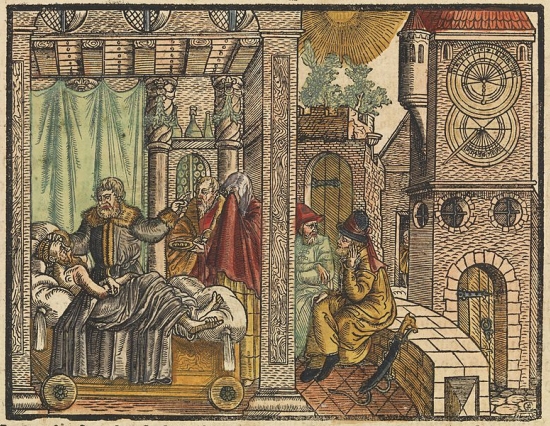
In 2 Kings 18-20, Isaiah 36-39, and 2 Chronicles 29-32, the Bible discusses the reign of King Hezekiah, who had several interactions with the prophet Isaiah. For example, the woodcutting shown above depicts 2 Kings 20:1-11. The king is dying, but the Lord hears his prayer and Isaiah tells him he will be healed. The King asks for a sign, and Isaiah causes a shadow to move in the direction opposite of the direction the sun would make it move.
Several extraBiblical references to King Hezekiah have been found, including a bulla (clay seal impression) bearing the phrase, “Belonging to Hezekiah, (son of) Ahaz, king of Judah.” However, there are no known extraBiblical references to the prophet Isaiah, at least not until now. While it is by no means certain, there is good archaeological evidence that a bulla from the prophet Isaiah has been found in the same area.
As discussed in Biblical Archaeology Review, Eilat Mazar (who also discovered King Hezekiah’s bulla) reports finding several other bullae in the same excavation. One bulla, found only 10 feet from King Hezekiah’s bulla, might very well belong to the prophet Isaiah. As Mazar writes:
Alongside the bullae of Hezekiah and the Bes family, 22 additional bullae with Hebrew names were found. Among these is the bulla of “Yesha‘yah[u] Nvy[?].” The obvious initial translation, as surprising as it might seem, suggests that this belonged to the prophet Isaiah.
It would make sense to find a bulla from Isaiah in the same excavation as bullae from King Hezekiah, but the conclusion is not ironclad. The name is pretty clear, but the last part, “Nvy[?],” is not. According to Mazar, the last part should signify the word “prophet,” but only if there is an aleph (’) at the end (where she put “[?]”). As she says:
Whether or not the aleph was added at the end of the lower register is speculative, as meticulous examinations of that damaged part of the bulla could not identify any remnants of additional letters.
So this bulla might just belong to a person named Isaiah who was not a prophet. However, given the archaeological context of the find, as well as the damaged nature of the artifact, there is at least a strong possibility that it represents the first extraBiblical evidence for the prophet Isaiah.

Good morning Jay,
Considering that the only references to the Hitties was the OT for a long time, not having extra-biblical data or objects is no impediment to the reality of Isaiah existing. I know that there are many who doubt the existence of many ancient peoples or places and the simple fact that we do not have physical evidences of these people or places is really irrelevant.
Using what extent evidence we have, each of us has to come to a decision as to what we believe existed back then. I have come across various people recently who are convinced that Jesus Christ is a mythological creation, even with the non-biblical evidences that do exist. Yet they believe in the reality of other earlier historical figures who have far less evidence for their existence (as in any documents that exist referencing them were written hundreds of years later).
We are never going to have full concrete evidence other than the biblical record for many of the entities and places mentioned in the bible. Some of that is simply because we will not be looking in the right places. some of it will be because any extent records of the time have not been preserved.
If we do get confirmation of some of the events, people and places mentioned in the bible, there will still be people who will dispute that evidence. Take, for example, the research from a couple of Israeli archaeologists from some years ago. They claimed that the evidence of the Northern Kingdom of Israel was unrelated to the Southern Kingdom of the Jews because the Northern Kingdom worshiped a couple of cow idols and that the biblical record was not accurate. This was in the face of the biblical record actually discussing the breakup of the Kingdom into two parts and the use of cow idols to maintain the split.
It is always nice to see more extra-biblical evidence arise, but should that matter? We have enough evidence for the veracity of the record, but it is up to people to determine for themselves whether or not they will accept that veracity.
Like everything, we are free to choose what we believe. There are people who have had direct personal interactions with the Living God and are willingly to doubt and walk away. I know some of these people and even with “in your face” evidences cannot accept these things.
Thank you for the article and may God our Saviour keep you and your family safe and well in His Spirit at this time.
regards
Bruce Rennie